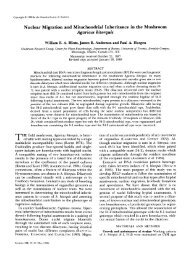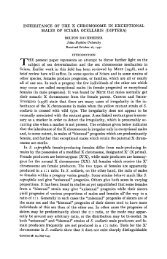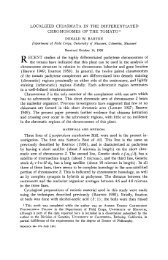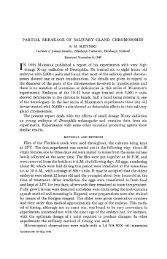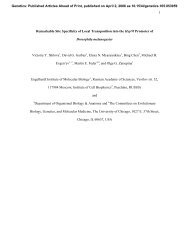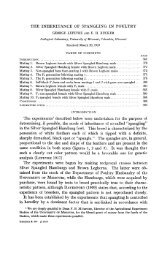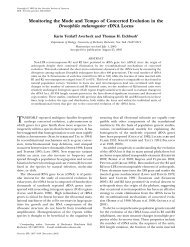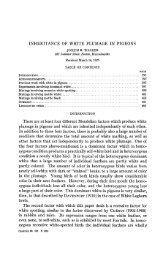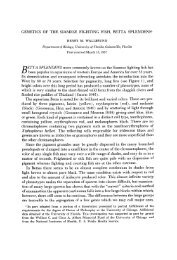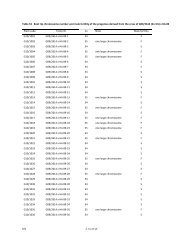abstracts of papers presented at the 1962 meetings - Genetics
abstracts of papers presented at the 1962 meetings - Genetics
abstracts of papers presented at the 1962 meetings - Genetics
Create successful ePaper yourself
Turn your PDF publications into a flip-book with our unique Google optimized e-Paper software.
ABSTRACTS 963<br />
tances. For genes more than 25 map units from <strong>the</strong> centromere, mitotic recombin<strong>at</strong>ion r<strong>at</strong>es rise<br />
linearly with UV dosage. However, for markers less than 15 units from <strong>the</strong> centromere homo-<br />
zygosis frequencies via mitotic recombin<strong>at</strong>ion <strong>at</strong>tain s<strong>at</strong>ur<strong>at</strong>ion <strong>at</strong> low UV doses. (This work has<br />
been supported by NIH grant #RG-6979.)<br />
HWANG, Y. L., E. SHULT, G. LINDEGREN, and C. C. LINDEGREN, Sou<strong>the</strong>rn Illinois University,<br />
Carbondale, Ill.: The chromosome maps <strong>of</strong> Saccharomyces.-The chromosome maps <strong>of</strong> Saccharomyces<br />
have been recently extended and new rel<strong>at</strong>ionships <strong>of</strong> centromeres, sites <strong>of</strong> affinity and<br />
gene loci have been demonstr<strong>at</strong>ed by hybridizing cultures from a variety <strong>of</strong> sources including<br />
mutants from Japan, Italy, and California.-The map <strong>of</strong> Saccharomyces shows ten centromeres,<br />
four sites <strong>of</strong> affinity and four linkage groups not assigned to known centromeres or affinity sites.<br />
One <strong>of</strong> <strong>the</strong> ten centromeres specified by <strong>the</strong> centromere marker met3 is newly identified. Three<br />
<strong>of</strong> <strong>the</strong> affinity sites exhibit preferential segreg<strong>at</strong>ion with chromosome V, and <strong>the</strong> fourth affinity<br />
site shows nonrandom assortment with chromosome VIII. Twentytwo gene loci have been<br />
newly loc<strong>at</strong>ed. The d<strong>at</strong>a previously reported by LINDEGREN, et al., by HAWTHORNE and MORTI-<br />
MER, and by OSHIMA comprise a total <strong>of</strong> 57 gene loci.<br />
IVES, P. T., and G. R. FINK, Amherst College, Amherst, Mass.: Comparison <strong>of</strong> transloc<strong>at</strong>ion<br />
and crossover chromosomes produced by y irradi<strong>at</strong>ion <strong>of</strong> Drosophila males.-Transloc<strong>at</strong>ions<br />
(Ts) <strong>of</strong> chromosomes 2 and 3 were derived from days 5 and 6 sperm <strong>of</strong> Oregon-R/rucuca males<br />
and crossovers from days 9 and 10 sperm, using an exhaustive m<strong>at</strong>ing schedule <strong>at</strong> 25°C after<br />
two kr. Tests showed homozygous lethality in 84 <strong>of</strong> 102 Ts and in 24 <strong>of</strong> 105 non-T second<br />
chromosomes also derived from days 5 and 6 sperm. The estim<strong>at</strong>ed lethality due to a T is .35<br />
<strong>of</strong> a lethal for each <strong>of</strong> its two chromosomes, with 2.7 T lethals to one non-T lethal per chromosome.<br />
In contrast 11 <strong>of</strong> 141 crossover chromosomes appearing in males and ten <strong>of</strong> 172 noncmssover<br />
sibling third chromosomes from days 9 and 10 sperm were recessive lethals, <strong>the</strong><br />
difference in <strong>the</strong>se two frequencies being nonsignificant (P = .6) .-The lower lethality in<br />
crossovers us. Ts and <strong>the</strong> absence <strong>of</strong> a comparable increase in proportion <strong>of</strong> lethals in crossover<br />
chromosomes support <strong>the</strong> views th<strong>at</strong> induced crossovers and Ts are genetically different <strong>at</strong> <strong>the</strong>ir<br />
exchange sites (PATTERSON and STONE 1934) and th<strong>at</strong> if both result from induced chromosome<br />
breakage <strong>the</strong>n lethality arises not from this breakage but probably from a position effect <strong>of</strong> genes<br />
not <strong>the</strong>mselves affected by <strong>the</strong> irradi<strong>at</strong>ion. (Earlier comparable studies were rendered uncritical<br />
by <strong>the</strong> l<strong>at</strong>er discovery <strong>of</strong> widely divergent induced mut<strong>at</strong>ion frequencies <strong>at</strong> different sperm<strong>at</strong>ogenic<br />
stages.) A difference between induced male and normal female crossingover is still ap parent in <strong>the</strong>ir very different proportion<strong>at</strong>e chromosomal distributions. (Supported by Contract<br />
No. AT(30-1)2467 from <strong>the</strong> U.S.A.E.C.)<br />
IYENGAR, SHANTA V., and RACHEL M. BAKER, Louisiana St<strong>at</strong>e University, B<strong>at</strong>on Rouge, La.:<br />
The influence <strong>of</strong> temper<strong>at</strong>ure on <strong>the</strong> p<strong>at</strong>tern <strong>of</strong> insemin<strong>at</strong>ion by Drosophila melanogaster males9<br />
-Three groups <strong>of</strong> 20 young Drosophila males from each <strong>of</strong> two different stocks were tre<strong>at</strong>ed as<br />
follows: group 1, untre<strong>at</strong>ed controls; group 2 and 3 males subjected to 36°C and -8°C respectively<br />
for 15 minutes immedi<strong>at</strong>ely prior to m<strong>at</strong>ing. Each male <strong>of</strong> <strong>the</strong> first type was placed<br />
with three virgin females for a day and replaced by <strong>the</strong> second type male for <strong>the</strong> next 24 hours<br />
after which <strong>the</strong> females were individualized and transferred to fresh vials daily for ten days.<br />
The total <strong>of</strong>fspring for groups 1, 2, and 3 were respectively 2578, 3419, and 849 indic<strong>at</strong>ing<br />
about a 30 percent increase in group 2 and about a 66 percent decrease in group 3. None <strong>of</strong><br />
<strong>the</strong> females in groups 1 or 3 were fertilized by both males, while in group 2, 10.9% were. The<br />
percentage <strong>of</strong> unfertilized females in groups 1, 2, and 3 were respectively 27.11%, 7.27%, and<br />
71.4%. While a cold “shock” impairs <strong>the</strong> physical activity and <strong>the</strong>refore <strong>the</strong> fertility <strong>of</strong> <strong>the</strong> male,<br />
a mild he<strong>at</strong> “shock” seems to enhance, r<strong>at</strong>her than impair, <strong>the</strong> fertility <strong>of</strong> <strong>the</strong> male due to one<br />
or several <strong>of</strong> <strong>the</strong> following: (1) acceler<strong>at</strong>ed sperm<strong>at</strong>ogenesis, (2) larger number <strong>of</strong> sperm per<br />
ejacul<strong>at</strong>e, (3) increased motility <strong>of</strong> <strong>the</strong> sperm in <strong>the</strong> male, as well as in <strong>the</strong> recipient female as





